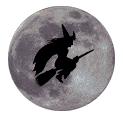|
|
 |
"Darksome night and shining moon,
harken to the Witches'
Rune."
|
 |
|
Cycle of the Moon
Most Witches perform rituals to honor the Goddess at the full moon and many
also observe the other moon phases. These are the 'regularly scheduled' holy days, actually nights, of Wiccan practice. These
"moon-time" rituals are commonly called Esbats. Based on the lunar cycle, they occur monthly rather than weekly.
Spellwork, or magic, may also be performed at the discretion of the Coven or Solitary Witch.
The lunar cycle has four
phases that can be used for certain types of spellwork. The full moon is the most often used time as it is the time of greatest
power. As the full moon is slowly decreasing toward the new moon, it is said to be in its 'waning' phase. Spellwork during
this time is done to decrease, diminish, or banish unwelcome energies. Very little spellwork is done during the new moon,
as it is a time to rest and meditate while the moon is dark and in its 'resting' phase. As the moon slowly starts to increase
back towards a full moon, it is said to be in its 'waxing' phase. Spellwork done during this time is designed to pull wanted
energy to the witch. Spells of increase and attraction are done during this phase.
Depending on coven practices or
the solitary witch, the working phases last from three to seven days. In a coven, where there are more people to raise energy,
a working may be performed three days before to three days after the actual full, new, or quarter moon. In solitary practice,
it is usually better to limit the working time to one day before or one day after the actual date. The working energies are
strongest on the actual dates so a solitary may find it more effective to use these shorter time periods.
In almost
all indigenous cultures, the year was measured according to the cycle of the moon, rather than the cycle of the sun. In a
lunar calendar, there are thirteen months in the year to correspond to the thirteen full moons in one moon cycle. Months began
at the new moon and were named for naturally occuring events during that particular time period. For instance, the full moon
in January might have been called the Ice Moon, the Wolf Moon, or the Starving Moon.
A second full moon in the same
calendar month is usually called a "Blue Moon." However, the thirteenth moon in a year might also have been called the Lucky
Moon, Unlucky Moon, Ghost Moon, Hunter’s Moon, Fisherman’s Moon, Dragon Moon, Fairy Moon, and many other names
depending on the culture.
Most Wiccans use moon names and their correspondences to determine what sort of spellwork
is appropriate for a particular full moon rite. As with everything else in Wiccan practice, the list I have is an example
and not to be taken as the only option.
|
 |
|
More Info
|
 |
|
|
 |
|
|
|
|
|
PLEASE NOTE: All graphics and written materials on this site are copyright © protected by myself or someone else. Unless
otherwise noted, all written material on this site is my original material. Material that was not created by me is credited
to its author. Graphics are credited to and obtained from the sites of the artists who created them, as far as I know. Please
do not copy anything from this site, either written or graphic. Visit the creators' sites, buy or borrow their books, or visit
'research' sites and download directly from there. Always include credit and copyright info. To copy or reprint any of my
original information, please contact me for permission.
Witchmoon - © Unknown: I lost the credit info
for this one in a computer crash.
Help finding its owner would be appreciated.
|
|
|
 |

